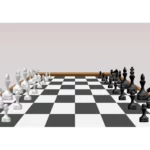Are you a chess enthusiast looking for the perfect chess board to enjoy your favorite game? You might be wondering how to choose a chess board that suits your needs, preferences, and style. In this article, we’ll guide you through the process of selecting the ideal chess board, discussing various factors and features to consider. Let’s get started!
Understanding Chess Boards
Before diving into the selection process, it’s essential to understand the various aspects of chess boards.

Chess Board Materials
Chess boards are made from a variety of materials, including wood, plastic, vinyl, and even glass or metal. The choice of material depends on your personal preferences and budget. Wood is considered the most traditional and luxurious choice, while plastic and vinyl are more affordable and practical for casual players or those on a tight budget.
Chess Board Sizes
Chess boards come in different sizes, typically measured by the square size. The most common square size is 2 to 2.5 inches. However, there are smaller travel-sized boards and larger tournament-sized boards. When choosing a board size, consider the space you have available and whether you plan to use the board for casual play, tournaments, or travel.
Chess Board Styles
There are various chess board styles, from traditional Staunton designs to themed boards featuring popular characters or historical figures. The choice of style is a matter of personal taste, so pick one that reflects your personality and interests.
Key Factors to Consider
When choosing a chess board, you should consider several factors to ensure you make the right choice for your needs.
Your Skill Level
Consider your skill level when selecting a chess board. Beginners may prefer a more affordable, straightforward board, while advanced players might opt for a higher-quality board with additional features, such as grid notation or built-in clocks.
Budget
Your budget plays a significant role in determining the type of chess board you can afford. Wooden boards are often more expensive, while plastic and vinyl options are more budget-friendly. Determine how much you’re willing to spend before starting your search.
Purpose
Think about the primary purpose of your chess board. Will it be used for casual play, tournament games, or travel? The intended use will help guide your decision-making process when selecting the right chess board.
Portability
If you plan to take your chess board on the go, portability is a crucial factor to consider. Look for lightweight, foldable boards with storage compartments for easy transport.
Chess Board Features
Some chess boards come with additional features that can enhance your playing experience.
Grid Notation
Grid notation on the board’s borders helps track moves during a game, making it easier to review your strategy and improve your skills. This
feature is particularly useful for beginners and those who play competitively.
Board Design and Aesthetics
The design and aesthetics of your chess board can impact your enjoyment of the game. Choose a board that appeals to your personal taste, whether it’s a classic wooden board or a unique, themed design.
Buying Guide
When you’re ready to purchase a chess board, consider the following tips to ensure a smooth buying experience.
Online vs. Physical Stores
Both online and physical stores have their advantages and disadvantages. Shopping online offers a wider selection and potentially better prices, but you won’t have the opportunity to examine the board’s quality in person. Visiting a physical store allows you to see and touch the board before purchasing, but the selection may be more limited.
Warranty and Return Policy
Check the warranty and return policy before purchasing a chess board. A reputable seller should offer a reasonable warranty and return policy, giving you peace of mind in case you encounter any issues or defects with your purchase.
Conclusion
Choosing the perfect chess board involves understanding the different types of boards, considering key factors such as your skill level, budget, and purpose, and evaluating additional features that may enhance your playing experience. By following this guide, you’ll be well on your way to finding a chess board that fits your needs and brings you enjoyment for years to come.
FAQ
The size of a chess board is typically determined by the size of its squares. A standard square size is 2 to 2.5 inches, but smaller and larger sizes are available. Consider the space you have available and the intended use of the board when selecting the right size.
The best material for a chess board depends on your preferences and budget. Wood is considered the most traditional and luxurious choice, while plastic and vinyl are more affordable and practical options.
Themed chess boards can be suitable for serious play if they meet the size and material requirements for competitive games. However, some themed boards may prioritize aesthetics over functionality, making them better suited for casual play or display.
To clean and maintain your chess board, gently dust it with a soft cloth and use a mild cleaner for any stains or spills. Avoid using abrasive cleaners or soaking the board in water, as this can damage the material. Store the board in a cool, dry place away from direct sunlight to prevent warping or fading.
Yes, you can use your own chess pieces with a new chess board, provided the pieces and board are compatible in terms of size and style. Ensure the base diameter of the pieces is approximately 75-80% of the square size for a proper fit.



